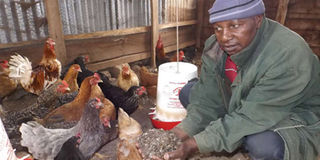Diary of a Poultry Farmer: Quality of feeds affect egg production

Steven Kariuki scoops a mixture of chicken manure and ash that is used to make homemade organic fertilisers. For optimum growth and production in your chicken, the percent crude protein for chicks, growers and layers mash should be adequate. PHOTO | JOHN GITHINJI | NATION MEDIA GROUP
What you need to know:
- Poor quality feeds can lead to slow growth, low egg production, diseases or even death of your chicken.
- For optimum growth and production, the per cent protein (Crude Protein) for chicks, growers and layers mash should be adequate.
- Light is important for sexual maturity of egg layers whether they be exotic or kienyeji,” she told me. “Light stimulates the reproductive cycle of hens and determines the egg production.
- Between day one and four weeks, the chicks need 24 hours of exposure to light, meaning day and night.
Last week, I recounted my painful experiences to keep the chicks warm even as the nasty June cold season set in.
I lost 29 chicks but for now, I can say that rest are out of danger and they won’t need more supplemental heat.
However, this is not the only challenge farmers like me who are raising young chicks will face.
To illustrate my point, two weeks ago, I received a rather unexpected call from Winstone of Kitengela on the outskirts of Nairobi. He sounded rather distressed.
“My 607 Kenchic layers have just turned 22 weeks old,” he posited.
Having corresponded with him from last year before he started poultry farming, I felt he had made great progress and congratulated him on a good job.
But then, he added this: “The problem is I haven’t seen an egg!”
Okay, this is a common dilemma many farmers face and sometimes what many don’t realise is that unless you get it right from the very beginning, egg production will become a problem later.
This is my experience with Kari improved kienyeji chicken; when the birds are healthy and the nutrition is optimum, the hens will start to lay eggs between 4.5 and five months.
As such, the first obvious thing that came to my mind was the source of his chicken feeds.
You see, I have come to learn from animal experts that besides genetics (keeping a breed with good characteristics), productivity in birds and animals is also dependent on feed conversion efficiency, disease-control and feed quality.
“Poor quality feeds can lead to slow growth, low egg production, diseases or even death,” I told Winstone.
I then asked him where he buys his feeds. He proudly mentioned the name of one of the leading feed millers in town.
At this point, I enquired if he had ever tested the quality of the feeds. Like other farmers, he hadn’t.
LIGHT MANAGEMENT
“The only way you can know if the feeds you are using are of the right quality is to take a sample to a reputable laboratory for a test called proximate analysis,” I said.
“For optimum growth and production, the per cent protein (Crude Protein) for chicks, growers and layers mash should be adequate”.
I also told him that for optimum growth, the chick mash offered to the chicks from day old to eight weeks should contain a high protein content between 18 to 20 per cent.
For sure, I twice tested a sample of chick mash from one miller that I considered reputable and the results were rather disappointing; the crude protein was about 16 per cent.
For now, you can take this to the bank: If you are raising the fast growing broilers (chicken raised solely for meat production) that need to be ready for the market at six weeks, the protein requirement is much higher, a whooping 22 per cent.
I also asked him to consider the light management during the entire growth period.
Sometime back, I spoke to Sophie Miyumo, the guru of animal sciences at Egerton University (SoG Oct 1, 2016). She intimated to me that besides the feed quality and genes, light management during the entire growth period impacts egg production later.
“Light is important for sexual maturity of egg layers whether they be exotic or kienyeji,” she told me. “Light stimulates the reproductive cycle of hens and determines the egg production.”
EXPENSIVE TO MAINTAIN
I did some reading on the subject and found that light management requires the so-called Step-up, Step-down, and Step-up approach.
Simply put, between day one and four weeks, the chicks need 24 hours of exposure to light, meaning day and night.
Then, between week five and 18 when they are expected to start laying eggs, you step down the light hours to eight and increase the dark hours to 16.
Finally, at week 18, you start increasing the light hours weekly so that by week 20 to 22 when the egg laying rate should be about five per cent, you have 16 -light hours and eight dark hours.
What puzzles me is how I can achieve this balance between light and dark hours in the tropics where the day and night hours are almost the same.
Some good news. A week ago, I got electricity connected to my farm in Njiru, meaning I can now easily ensure that the chicks are exposed to light during the day and night for the next four weeks.
I had been using a pressure lamp which was expensive to maintain.
Last week, I send Cleophas to buy two low power incandescent bulbs for lighting. I was advised to avoid the ordinary fluorescent light bulbs because their light doesn’t spread evenly in the room.





